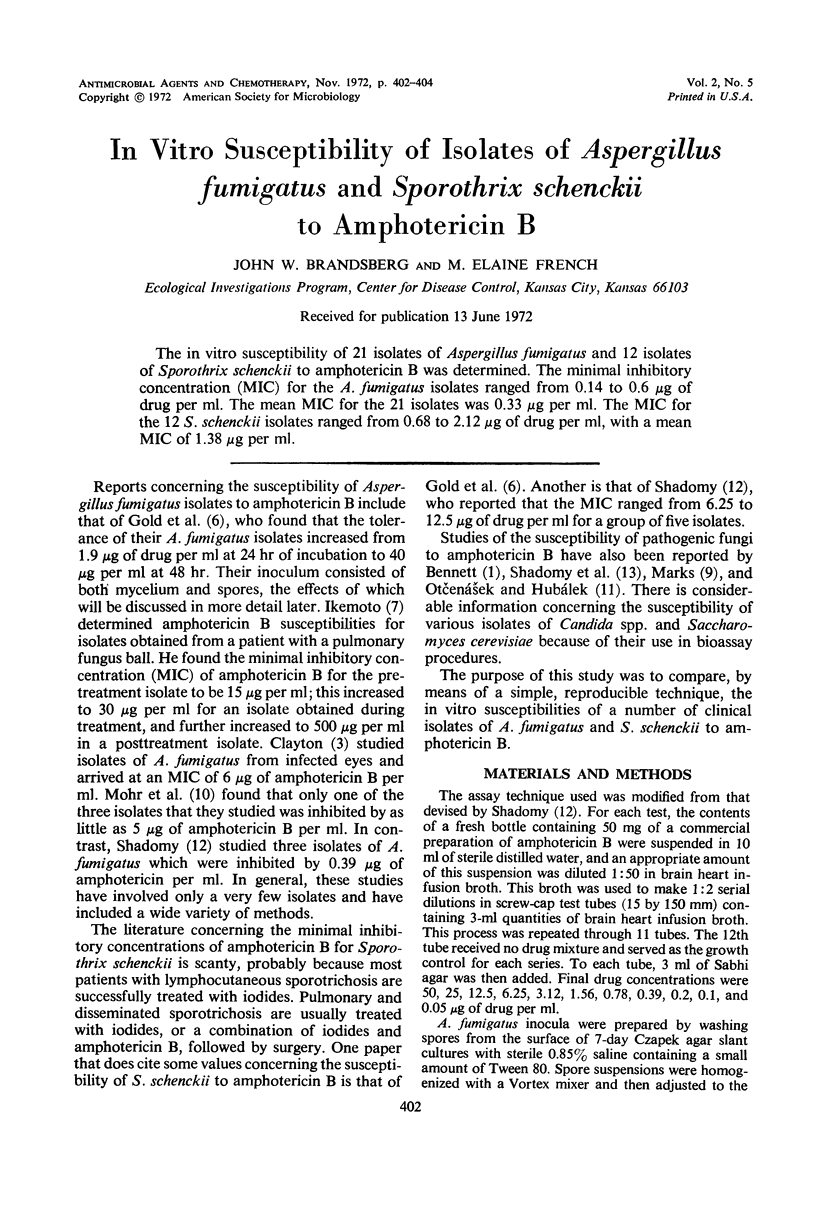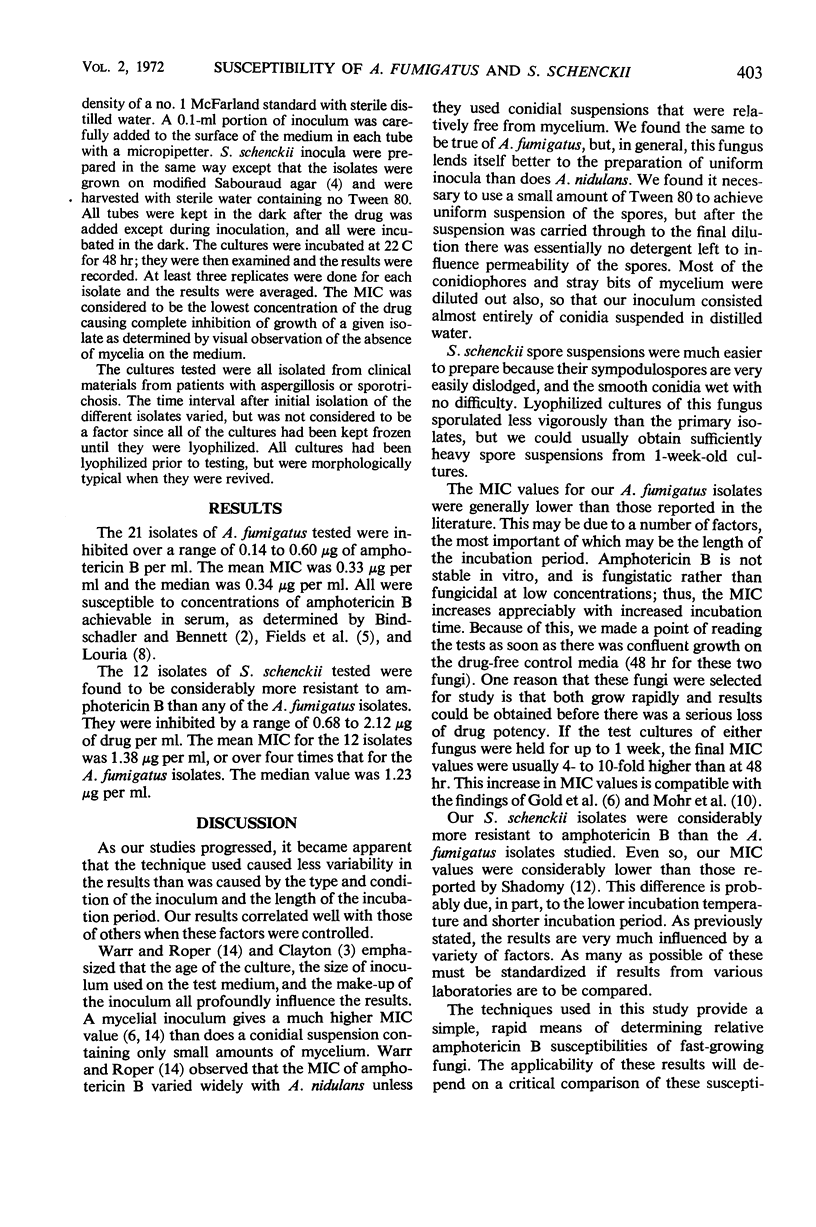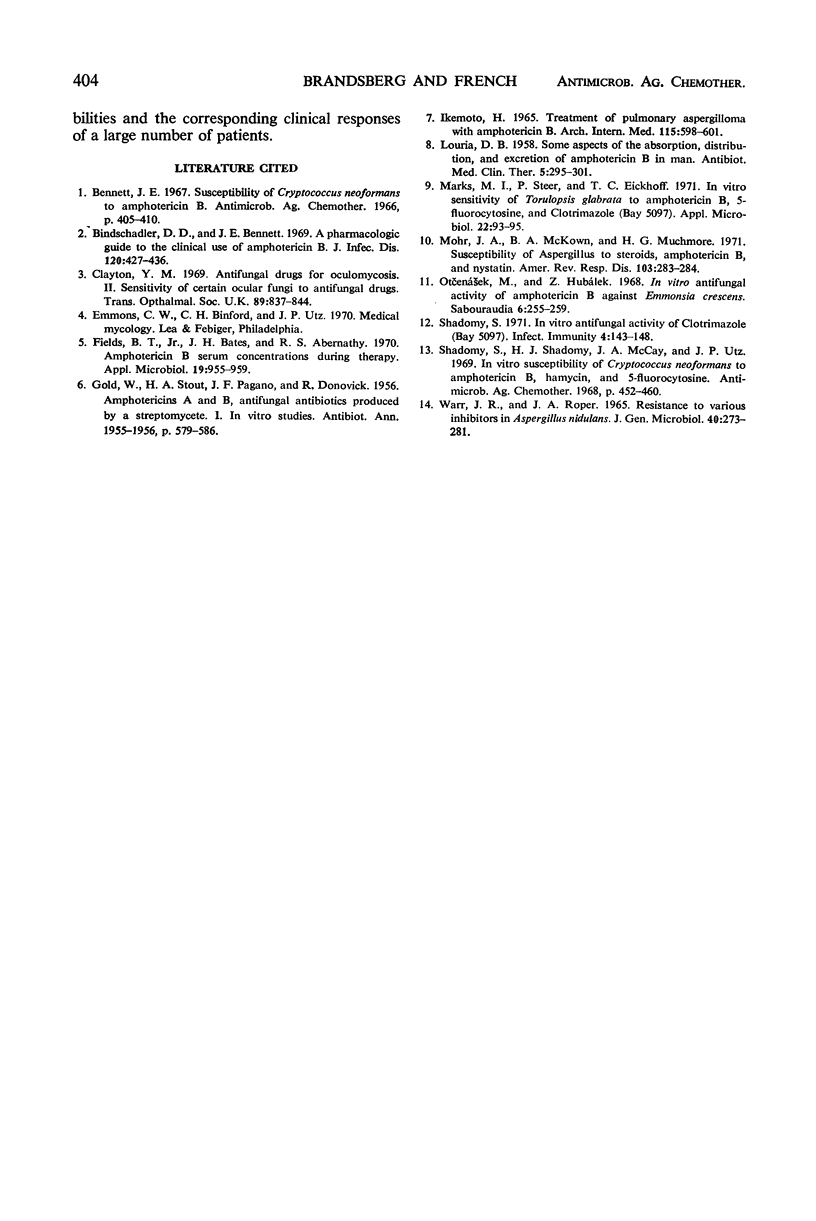Abstract
The in vitro susceptibility of 21 isolates of Aspergillus fumigatus and 12 isolates of Sporothrix schenckii to amphotericin B was determined. The minimal inhibitory concentration (MIC) for the A. fumigatus isolates ranged from 0.14 to 0.6 μg of drug per ml. The mean MIC for the 21 isolates was 0.33 μg per ml. The MIC for the 12 S. schenckii isolates ranged from 0.68 to 2.12 μg of drug per ml, with a mean MIC of 1.38 μg per ml.
Full text
PDF


Selected References
These references are in PubMed. This may not be the complete list of references from this article.
- Bennett J. E. Susceptibility of Cryptococcus neoformans to amphotericin B. Antimicrob Agents Chemother (Bethesda) 1966;6:405–410. doi: 10.1128/AAC.6.4.405. [DOI] [PubMed] [Google Scholar]
- Bindschadler D. D., Bennett J. E. A pharmacologic guide to the clinical use of amphotericin B. J Infect Dis. 1969 Oct;120(4):427–436. doi: 10.1093/infdis/120.4.427. [DOI] [PubMed] [Google Scholar]
- Clayton Y. M. Antifungal drugs for oculomycosis. II. Sensitivity of certain ocular fungi to antifungal drugs. Trans Ophthalmol Soc U K. 1970;89:837–844. [PubMed] [Google Scholar]
- DONOVICK R., GOLD W., PAGANO J. F., STOUT H. A. Amphotericins A and B, antifungal antibiotics produced by a streptomycete. I. In vitro studies. Antibiot Annu. 1955;3:579–586. [PubMed] [Google Scholar]
- Fields B. T., Jr, Bates J. H., Abernathy R. S. Amphotericin B serum concentrations during therapy. Appl Microbiol. 1970 Jun;19(6):955–959. doi: 10.1128/am.19.6.955-959.1970. [DOI] [PMC free article] [PubMed] [Google Scholar]
- IKEMOTO H. TREATMENT OF PULMONARY ASPERGILLOMA WITH AMPHOTERICIN B. Arch Intern Med. 1965 May;115:598–601. doi: 10.1001/archinte.1960.03860170080017. [DOI] [PubMed] [Google Scholar]
- LOURIA D. B. Some aspects of the absorption, distribution, and excretion of amphotericin B in man. Antibiotic Med Clin Ther (New York) 1958 May;5(5):295–301. [PubMed] [Google Scholar]
- Marks M. I., Steer P., Eickhoff T. C. In vitro sensitivity of Torulopsis glabrata to amphotericin B, 5-fluorocytosine, and clotrimazole (Bay 5097). Appl Microbiol. 1971 Jul;22(1):93–95. doi: 10.1128/am.22.1.93-95.1971. [DOI] [PMC free article] [PubMed] [Google Scholar]
- Mohr J. A., McKown B. A., Muchmore H. G. Susceptibility of Aspergillus to steroids, amphotericin B, and nystatin. Am Rev Respir Dis. 1971 Feb;103(2):283–284. doi: 10.1164/arrd.1971.103.2.283. [DOI] [PubMed] [Google Scholar]
- Otcenásek M., Hubálek Z. In vitro antifungal activity of amphotericin B against Emmonsia crescens. Sabouraudia. 1968 Jun;6(3):255–259. [PubMed] [Google Scholar]
- Shadomy S. In vitro antifungal activity of clotrimazole (Bay b 5097). Infect Immun. 1971 Aug;4(2):143–148. doi: 10.1128/iai.4.2.143-148.1971. [DOI] [PMC free article] [PubMed] [Google Scholar]
- Shadomy S., Shadomy H. J., McCay J. A., Utz J. P. In vitro susceptibility of Cryptococcus neoformans to amphotericin B, hamycin, and 5-fluorocytosine. Antimicrob Agents Chemother (Bethesda) 1968;8:452–460. [PubMed] [Google Scholar]
- Warr J. R., Roper J. A. Resistance to various inhibitors in Aspergillus nidulans. J Gen Microbiol. 1965 Aug;40(2):273–281. doi: 10.1099/00221287-40-2-273. [DOI] [PubMed] [Google Scholar]


